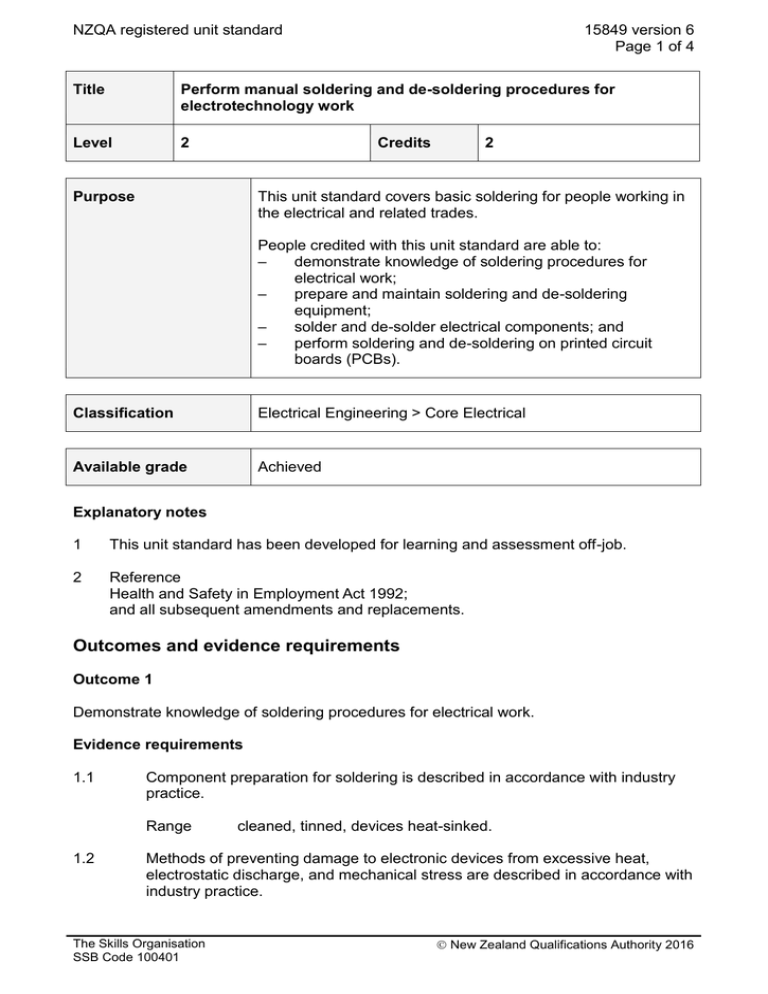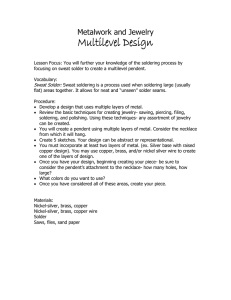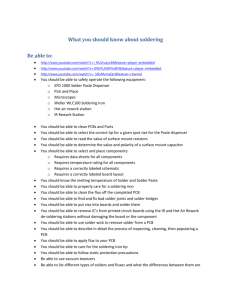NZQA registered unit standard 15849 version 6 Page 1 of 4
advertisement

NZQA registered unit standard 15849 version 6 Page 1 of 4 Title Perform manual soldering and de-soldering procedures for electrotechnology work Level 2 Credits Purpose 2 This unit standard covers basic soldering for people working in the electrical and related trades. People credited with this unit standard are able to: – demonstrate knowledge of soldering procedures for electrical work; – prepare and maintain soldering and de-soldering equipment; – solder and de-solder electrical components; and – perform soldering and de-soldering on printed circuit boards (PCBs). Classification Electrical Engineering > Core Electrical Available grade Achieved Explanatory notes 1 This unit standard has been developed for learning and assessment off-job. 2 Reference Health and Safety in Employment Act 1992; and all subsequent amendments and replacements. Outcomes and evidence requirements Outcome 1 Demonstrate knowledge of soldering procedures for electrical work. Evidence requirements 1.1 Component preparation for soldering is described in accordance with industry practice. Range 1.2 cleaned, tinned, devices heat-sinked. Methods of preventing damage to electronic devices from excessive heat, electrostatic discharge, and mechanical stress are described in accordance with industry practice. The Skills Organisation SSB Code 100401 New Zealand Qualifications Authority 2016 NZQA registered unit standard 15849 version 6 Page 2 of 4 1.3 Methods of preventing short circuits and dry joints are described in terms of iron temperature, iron tip and solder selection, and solder joint shape. 1.4 Safety and workshop procedures to be followed while soldering are described in accordance with Health and Safety legislation. Range eye protection, ventilation, selection of clothing, work position. Outcome 2 Prepare and maintain soldering and de-soldering equipment. Evidence requirements 2.1 Soldering and de-soldering equipment is chosen to suit the job in terms of the type of material and solder, bit size, heat requirement, and soldering location. 2.2 Soldering and de-soldering equipment is inspected to ensure user safety. Range 2.3 electric cord set, vacuum hose where fitted, bits tight, handles undamaged and secure. Soldering and de-soldering tips are kept tinned, shaped, and clean in accordance with industry practice. Outcome 3 Solder and de-solder electrical components. Range components may include but are not limited to – wiring lugs, connectors, connections. Evidence of ten solder joints is required. Evidence requirements 3.1 Solder, and flux where applicable, are chosen to match the job in terms of size and type of solder. 3.2 Materials are cleaned and secured in position ready for soldering task. 3.3 Materials are joined without damage to surrounding components and insulation, and solder is not overheated. 3.4 Soldered joints are completed in accordance with industry practice. Range 3.5 joints are smooth; absence of – short circuits, dry joints, jagged edges, excess solder. Safety and workshop procedures are followed in accordance with current Health and Safety legislation. The Skills Organisation SSB Code 100401 New Zealand Qualifications Authority 2016 NZQA registered unit standard 15849 version 6 Page 3 of 4 Outcome 4 Perform soldering and de-soldering on printed circuit boards (PCBs). Range solder at least ten components, de-solder at least ten components, bridge five PCB tracks. Evidence requirements 4.1 Anti-static precautions are followed in accordance with industry practice. 4.2 Resin-core solder is chosen to suit the job in terms of solder size. 4.3 Components are cleaned and secured in position in accordance with industry practice. 4.4 Components are soldered to PCBs without damage to surrounding components, tracks, and pads. 4.5 Joints are completed in accordance with industry practice. Range solder shape is filleted; component leads are trimmed; absence of short circuits, dry joints, jagged edges, excess solder. 4.6 Components are removed from PCBs and replaced without causing heat or stress damage to tracks and pads. 4.7 PCB bridges are installed in accordance with industry practice. 4.8 Safety and workshop procedures are followed while soldering in accordance with current Health and Safety legislation. Replacement information This unit standard replaced unit standard 5923. Planned review date 31 December 2014 Status information and last date for assessment for superseded versions Process Version Date Last Date for Assessment Registration 1 10 February 1999 31 December 2013 Revision 2 3 April 2001 31 December 2013 Review 3 26 May 2005 31 December 2013 Revision 4 26 January 2007 N/A Rollover and Revision 5 15 March 2012 N/A The Skills Organisation SSB Code 100401 New Zealand Qualifications Authority 2016 NZQA registered unit standard 15849 version 6 Page 4 of 4 Process Version Date Last Date for Assessment Revision 6 15 January 2014 N/A Consent and Moderation Requirements (CMR) reference 0003 This CMR can be accessed at http://www.nzqa.govt.nz/framework/search/index.do. Please note Providers must be granted consent to assess against standards (accredited) by NZQA, before they can report credits from assessment against unit standards or deliver courses of study leading to that assessment. Industry Training Organisations must be granted consent to assess against standards by NZQA before they can register credits from assessment against unit standards. Providers and Industry Training Organisations, which have been granted consent and which are assessing against unit standards must engage with the moderation system that applies to those standards. Requirements for consent to assess and an outline of the moderation system that applies to this standard are outlined in the Consent and Moderation Requirements (CMR). The CMR also includes useful information about special requirements for organisations wishing to develop education and training programmes, such as minimum qualifications for tutors and assessors, and special resource requirements. Comments on this unit standard Please contact The Skills Organisation reviewcomments@skills.org.nz if you wish to suggest changes to the content of this unit standard. The Skills Organisation SSB Code 100401 New Zealand Qualifications Authority 2016





